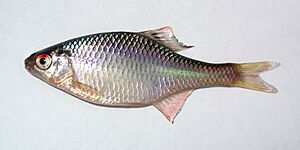European bitterling facts for kids
Quick facts for kids European bitterling |
|
|---|---|
 |
|
| Conservation status | |
| Scientific classification | |
| Synonyms | |
|
The European bitterling (Rhodeus amarus) is a small, colorful freshwater fish that lives in cool waters. It belongs to a group of fish called Cyprinidae, which also includes carps and minnows. This fish is special because of how it lays its eggs!
Contents
About the European Bitterling
The European bitterling is found across Europe. It lives in rivers like the Rhone River in France all the way to the Neva River in Russia. It was first described by a scientist named Marcus Elieser Bloch in 1782.
What Does It Look Like?
This fish can grow up to about 10 centimeters (4 inches) long. It has a shiny, silvery body with hints of green and pink, especially during breeding season.
Where Does It Live?
European bitterlings like to live in shallow waters. They prefer places with lots of plants and soft bottoms made of sand or mud. You can often find them swimming among water plants.
What Does It Eat?
The European bitterling mainly eats plants that grow in the water. But it also enjoys a snack of small worms, tiny crustaceans (like little shrimp), and insect larvae.
Reproduction and Life Cycle
European bitterlings have a very unique way of having babies. When it's time to lay eggs, the female fish looks for a freshwater mussel. She uses a special tube called an ovipositor to carefully place her eggs inside the mussel.
The mussel acts like a safe nursery for the eggs. The young fish hatch inside the mussel and stay protected there for about a month. After they grow a bit, they swim out of the mussel as tiny larvae. Both male and female bitterlings can start having their own babies when they are about 1 year old and around 3 to 3.5 centimeters (1 to 1.4 inches) long.
Interesting Facts
Long ago, this fish was used in a very unusual way! Scientists noticed that if female bitterlings were exposed to certain hormones, their ovipositors would stick out more. This was a simple way to observe how hormones could affect a fish's body.



